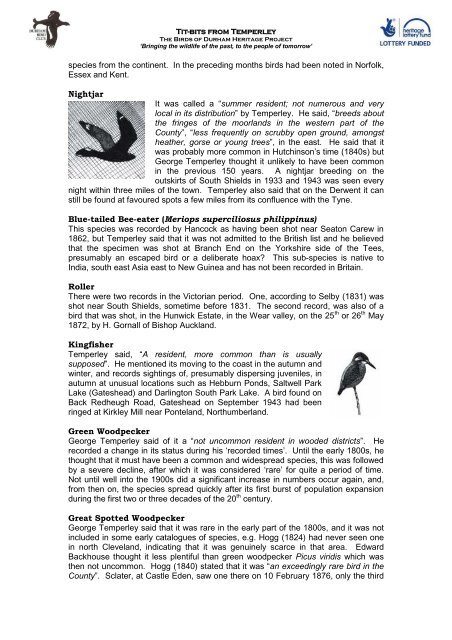'Tit-bits from Temperley' - Durham Bird Club
'Tit-bits from Temperley' - Durham Bird Club
'Tit-bits from Temperley' - Durham Bird Club
You also want an ePaper? Increase the reach of your titles
YUMPU automatically turns print PDFs into web optimized ePapers that Google loves.
Tit-<strong>bits</strong> <strong>from</strong> Temperley<br />
The <strong>Bird</strong>s of <strong>Durham</strong> Heritage Project<br />
‘Bringing the wildlife of the past, to the people of tomorrow’<br />
species <strong>from</strong> the continent. In the preceding months birds had been noted in Norfolk,<br />
Essex and Kent.<br />
Nightjar<br />
It was called a “summer resident; not numerous and very<br />
local in its distribution” by Temperley. He said, “breeds about<br />
the fringes of the moorlands in the western part of the<br />
County”, “less frequently on scrubby open ground, amongst<br />
heather, gorse or young trees”, in the east. He said that it<br />
was probably more common in Hutchinson‟s time (1840s) but<br />
George Temperley thought it unlikely to have been common<br />
in the previous 150 years. A nightjar breeding on the<br />
outskirts of South Shields in 1933 and 1943 was seen every<br />
night within three miles of the town. Temperley also said that on the Derwent it can<br />
still be found at favoured spots a few miles <strong>from</strong> its confluence with the Tyne.<br />
Blue-tailed Bee-eater (Meriops superciliosus philippinus)<br />
This species was recorded by Hancock as having been shot near Seaton Carew in<br />
1862, but Temperley said that it was not admitted to the British list and he believed<br />
that the specimen was shot at Branch End on the Yorkshire side of the Tees,<br />
presumably an escaped bird or a deliberate hoax? This sub-species is native to<br />
India, south east Asia east to New Guinea and has not been recorded in Britain.<br />
Roller<br />
There were two records in the Victorian period. One, according to Selby (1831) was<br />
shot near South Shields, sometime before 1831. The second record, was also of a<br />
bird that was shot, in the Hunwick Estate, in the Wear valley, on the 25 th or 26 th May<br />
1872, by H. Gornall of Bishop Auckland.<br />
Kingfisher<br />
Temperley said, “A resident, more common than is usually<br />
supposed”. He mentioned its moving to the coast in the autumn and<br />
winter, and records sightings of, presumably dispersing juveniles, in<br />
autumn at unusual locations such as Hebburn Ponds, Saltwell Park<br />
Lake (Gateshead) and Darlington South Park Lake. A bird found on<br />
Back Redheugh Road, Gateshead on September 1943 had been<br />
ringed at Kirkley Mill near Ponteland, Northumberland.<br />
Green Woodpecker<br />
George Temperley said of it a “not uncommon resident in wooded districts”. He<br />
recorded a change in its status during his „recorded times‟. Until the early 1800s, he<br />
thought that it must have been a common and widespread species, this was followed<br />
by a severe decline, after which it was considered „rare‟ for quite a period of time.<br />
Not until well into the 1900s did a significant increase in numbers occur again, and,<br />
<strong>from</strong> then on, the species spread quickly after its first burst of population expansion<br />
during the first two or three decades of the 20 th century.<br />
Great Spotted Woodpecker<br />
George Temperley said that it was rare in the early part of the 1800s, and it was not<br />
included in some early catalogues of species, e.g. Hogg (1824) had never seen one<br />
in north Cleveland, indicating that it was genuinely scarce in that area. Edward<br />
Backhouse thought it less plentiful than green woodpecker Picus viridis which was<br />
then not uncommon. Hogg (1840) stated that it was “an exceedingly rare bird in the<br />
County”. Sclater, at Castle Eden, saw one there on 10 February 1876, only the third


